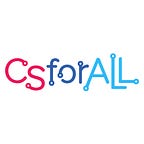High School Students Spearheading the Movement for Girls in Technology
A #WomensHistoryMonth post by Taylor Fang, high school student & co-founder of the Allgirlithm blog.
Last summer, 32 girls from around the world had the opportunity to participate in Stanford AI4ALL, a summer artificial intelligence camp especially for girls. While there, they completed their own research projects, focused on humanistic applications of AI like poverty or disaster relief, talked with and heard from a variety of AI programmers and advocates, and saw artificially-intelligent robots and machines at work.
As one of the participants, I was especially elated to meet so many other girls interested in the same things as I. While talking with two other alumni, we realized we had all grown up as one of only a handful of girls in our STEM activities. Additionally, the three of us being from Utah, Arkansas, and Arizona, we didn’t normally get access to opportunities like Stanford AI4ALL. During the last few days of camp — as a way to try and change this situation — we started Allgirlithm, a collaborative blog geared towards empowering women and girls in tech. We post news, resources, and opportunities, have several peer blog post writers, and partner with numerous other diversity initiatives, including CreAIte and PixelHacks. The collaborative spirit of Allgirlithm allowed me to glimpse the power of youth initiatives for computer science education across the US. Programs like Stanford AI4ALL serve as catalyzing forces for the next generation of computer advocates.
“high school students are a crucial part of the movement to make tech an inclusive and empowering place” — She++
Through participation in AI4ALL, and the year round support I receive as a member of the NCWIT Aspirations in Computing Community of 1000s of young women and girls aspiring in tech, I’ve seen many inspiring student-led initiatives and programs. Below I’ve detailed just a few student-led efforts to encourage more girls in tech, including my own project, Girls Explore Technology, or GET.
GET consisted of a five-week series of after school workshops for 24 middle school girls in Logan, Utah in collaboration with the Boys & Girls Club of Northern Utah and funded by AI4ALL’s Community Impact Grant. Each week, participants learned about and explored different aspects of technology, from computer science to artificial intelligence. GET aimed to help inspire and encourage participants to pursue technological fields through topic lectures, videos, hands-on projects, and guest speakers from the local university as well as computing fields. The girls had a great experience, as you can see by the attendee feedback:
“I have realized that there is so much more to computers than just programming.”
“I used to think that it wasn’t very fun but I learned it’s so fun.”
“I am more interested in it now and it seems a lot more creative.”
CreAIte runs artificial intelligence and art workshops for girls. Started in the Bay Area by three young women, they host workshops across the country, including in NYC, Austin, and Atlanta. Their workshops give an introduction to artificial intelligence and neural art, as well as featuring guest speakers from the tech industry. By exploring the combination of AI and art, they emphasize the diversity of AI’s applications and the creative thinking behind computer science.
Coder Girls is an international nonprofit dedicated to educating and enabling female K-12 students in computer science, started by Briana Berger. They have implemented chapters and curriculum with 85 Girl Scout councils and 350 schools to reach over 500,000 girls. Currently they teach coding to girls across the country and have chapters around the world, and also host a video competition to connect coding to other pursuits.
PixelHacks is the Bay Area’s first student-run, all-female high school hackathon. Catherine Yeo, PixelHacks’ founder and director, says that she was inspired to start PixelHacks “to inspire young girls and incite their interest in technology.” They have held two hackathons, in 2017 with 70 women and in 2018 with 120 women. Yeo was inspired to run PixelHacks II after “observing the tangible impact of PixelHacks on so many girls and seeing their newfound interest in programming grow.” Both events ran for 24 hours, and focused on building a software project to address a real-world problem, with prizes judged by a panel of professional women in tech fields.
These are just some of the different ideas and initiatives of high school students reaching out to girls in the community. Through my own experiences in these areas as well as through talking to others, I’ve seen that youth can be a force for spreading technology to other youth, and they often create a cycle of change in their communities. These students represent the frontier of tech inclusivity and accessibility, and for Women’s History Month especially, deserve to be celebrated for their dedication to spreading computer science to the next generation of female leaders and advocates.
Taylor Fang is a high school student in Utah. As STEM ambassador for the state of Utah, she volunteers to promote STEM to K-12 students, and is passionate about spreading these pursuits to more youth, especially girls. She was recently recognized by the National Center for Women & Information Technology (NCWIT) as an Aspirations in Computing National Honorable Mention, and selected as a Stanford she++ #include fellow. Besides STEM, she enjoys piano, tennis, and debate.
Read about her work on the Allgirlithm blog or get in touch at allgirlithm@gmail.com
